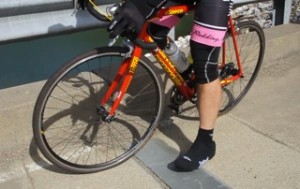UPDATED REGULARLY :As part of a bigger picture “Northern California Cycle Challenge” will be launching it’s first event “The Art of Survival” century, 45 mile, and 35 mile family ride. Cycle Siskiyou www.cyclesiskiyou.com is the bigger organization which is supporting the creation of this annual event. The intention behind the Northern California Cycle Challenge is to expose riders to an undiscovered part of Siskiyou county. Our motto is Fitness, Family and Fun which is reflected in the different course options.
This year the ride is taking place in the Tulelake/Klamath Falls region of Northern California and Southern Oregon. All three rides start and finish at the Tule Lake Butte Valley Fair Grounds in Tule Lake California.Held in conjunction with THE ART OF SURVIVAL, an exhibition at the Favell Museum in Klamath Falls that delves into the complexities of the Tule Lake Japanese American Segregation Center of WWII. We are excited not only to provide a great ride, but also to bring a powerful educational component to the focus of this years ride. The Pre ride meal and ride registration/packet pick up will be at the Discover Klamath Visitors Center on May 23d from 5:30 to 7:30 and the post event reception is at the exhibit site, The Favell Museum after the ride on the 24th of May from 3pm to 7pm. Registration and packet pick up will also be at the Tule Lake Butte Valley Fairgrounds the morning of the event starting at 7am. EARLY REGISTRATION HAS BEEN EXTENDED TO MAY 15TH.
The Art of Survival: Enduring the Turmoil of Tule Lake is a traveling exhibition probing the complexity of the Japanese American confinement site in Newell, California. Tule Lake became the only officially designated segregation center during WWII. Ruled under martial law, it was the most controversial of all the Camps.
Through haunting images of artifacts by fine art photographer Hiroshi Watanabe we glimpse into the lives of those who were held at Tule Lake and are encouraged to consider both the orchestration of daily life behind barbed wire and what it might have been like to live with constant turmoil and uncertainty. Oral histories allow us to hear varying views on some of the complex issues of Tule Lake in the voices of those held captive. And the art created both then and now, made from seemingly insignificant objects, beckons humility and connection.
Promoting education and increased awareness of what can happen when a nation loses reason to fear, this exhibition is designed to inspire critical thinking and action in regards to injustice. It also highlights the power of creativity to maintain dignity and well-being in times of harsh circumstance.
As well as looking at daily life, the exhibition explores the following topics: the power of propaganda; up-to-date terminology relating to the confinement experience; the history behind the incarceration; the difference between a Segregation Center and a Confinement Site; who were the people deemed “disloyal”, were they disloyal?; what happened when the Camp closed?
